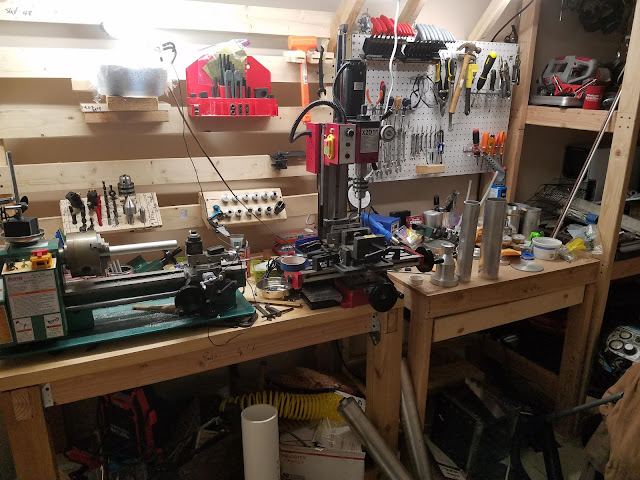Building the Thrust Stand
It took about a week from concept to build to get my thrust stand built. I had a hard time deciding between a horizontal and vertical thrust stand configuration. After weighing the pros and cons along with my experience using a horizontal test stand, I chose to go with a vertical setup because the ultimate aim will be to design a flyable motor. I also made sure to allow the test stand extensibility so that I could mount a rail in the future and test the entire rocket in a flight ready configuration. Another driving consideration was the testing of several experimental motor designs. My horizontal stand was troublesome anytime my rockets would not start because the chamber would fill with fuel that I would have to manually clean out between tests. The vertical position of the motor will help prevent a hard start from accumulated fuel.
The design is centered around a 1.5" x 1.5" x 1/8" thick walled square tubing backbone welded to 2" x 2" x 1/4" walled square tubing. The reasoning for such a strong base is that if I am testing a motor generating 1000 lbf then I will have to hold it down with at least that. Having the thick legs will allow me to weld on brackets that I can bury underground or mount to a concrete base.
There is a 24" x 20" shelf that will hold tanks and electronics. The verticals supporting the shelves were specifically one piece welded straight to the base so that they can act as a structural element should I need further reinforcement in the future. On the 1 ft over hang and 3 foot face there will be blast shielding to protect all of the electronics and isolate the pressure tanks in an explosion. I also plan on putting blast shielding around the pressurant tanks because they are simply 3 inch OD with 1/2" walled 6061 pipes that have caps welded on the ends. They aren't exactly hydro-testable.
I built a CAD model using FreeCad then using the FEM workbench I ran an analysis with 5000 lbs of force on the overhang. The upper surfaces of the legs are fixed and the trailing edge was fixed to act as a fulcrum. 5000 lbf was empirically determined to be the maximum amount of force before the stand started approaching plastic deformation. I only intend to test up to 500 lbf currently so there is plenty of a FoS to account for my shoddy welds (I've never stick welded before) with my homemade stick welder.
 |
| You can see my welder here |
This was a great chance for me to learn how to stick welding because of the thickness of the
metal. Not having to worry about burning through allowed me to focus on the molten puddle. I first tried with 1/8" 6013 welding rods but it turns out my welder didn't have the amperage to maintain an arc so I went to 1/16" 6013 and it struck great but not much penetration so I settled on 3/32" and this seems to work just fine. What I lacked in quality of welds I made up in quantity!
 |
| A shameless presentation of unarguably my best weld on the stand |
FreeCad CAD Modeling & FEM Software
This was my first time using FreeCAD .I don't really know much software but I do have a lot of CAD modeling experience so that I at least knew how things should work. If this is your first time CAD modeling, I would recommend using a free trial of SolidWorks or ProE first because there are a lot of step-by-step tutorials at YouTube University. Once you get a feel for the flow of these softwares then you could move onto FreeCAD because there is not a lot of feed back and the tutorials online are fairly lackluster. At first I was having a really difficult time trying to understand the stress distribution in the model because of a hot spot that was created right next to a non-critical member. It was blowing my scale out of proportion.
 |
| FreeCad Default |
I knew that this was useless to me unless I could figure out a way to adjust the color limits. So I poked around the source code for a few hours, I've never seriously coded in python, and came up with a macro that can probably be done more elegantly and in one line but it got the job done:
values = App.ActiveDocument.Results.StressValues
filtered_vals = []
Ulimit = 250
for v in values:
if v > Ulimit:
filtered_vals.append(Ulimit)
else:
filtered_vals.append(v)
App.ActiveDocument.Results.Mesh.ViewObject.setNodeColorByScalars(App.ActiveDocument.Results.NodeNumbers,filtered_vals)
I chose the Upper limit of 250 MPa because that is roughly where you are going to start running into plastic deformation and this is the result:
 |
| Much better |
It improved my visibility into the stress distributions greatly!



I actually learned the most about the software after poking around under the hood. Overall, it is not a bad software if you already know how the software is supposed to perform and you can't beat the price. Free always fits in my budget!

























































